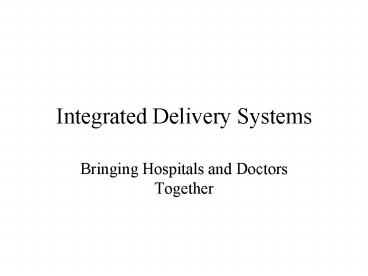Integrated Delivery Systems - PowerPoint PPT Presentation
1 / 15
Title:
Integrated Delivery Systems
Description:
Management Services Organization (MSO) ... For example, billing or administrative support. Support staff ... and rationalize services and systems. Disadvantages ... – PowerPoint PPT presentation
Number of Views:103
Avg rating:3.0/5.0
Title: Integrated Delivery Systems
1
Integrated Delivery Systems
- Bringing Hospitals and Doctors Together
2
Plan for Today
- Hospital-Physician integration
- More alphabet soup (PHO, MSO, IDS)
- Continuum involving looser and tighter forms of
integration - Advantages and disadvantages of each form
- The rise and fall of Penn State Geisinger Health
System
3
Systems Framework for Understanding Managed Care
EMPLOYERS
Plan Choices, Employee Premiums, Information
Contract for Product, Premiums/Benefits, Risk
Marketing, Product Development
Job preferences, Wage and Benefit Preferences
Payment, Risk, Practice Guidelines, Profiling
MCO
Type of Plan, Philosophy and Procedures for
Selection/Retention
Member services
Utilization management
Select Products, Join Plan
CARE
PHYSICIANS
Provider Network
CONSUMERS
Enrollees
Marketing, Advertising, Information, Reputation
Specialty, Style of Care, Discounts, Form of
Organization
Taxes, Votes
Contract for Product, Risk, Premiums, Benefits
Discounts, Specialized Services
Employee Plans, Medicare, Medicaid, Information
Treatment Facilities and Prescribed Services
Customer Volume
Admissions, Prescriptions, Referrals
Regulate Allowed Products, Behavior Relationships
GOVERNMENT
HOSPITALS OTHER SUPPLIERS
Adapted from Gold , Medical Care Research and
Review 52(3) 307-341, Figure 1.
4
Why integrate?
- Reduce average costs
- Higher prices
- Greater negotiating strength re. plans
- Lower costs and higher prices --gt higher profit
margins
5
How Can Integration Reduce Costs?
- Economies of scale
- Share administration and overhead
- Spread fixed costs
- Deploy clinical resources more effectively
- Physicians and hospitals pay more attention to
effects on each other - Information systems to manage business and care
6
Continuum of integration(Loosest to tightest)
- Physician-Hospital Organization (PHO)
- Management Services Organization (MSO)
- Integrated Delivery System (IDS)
7
Physician-Hospital Organization (PHO)
- Vehicle for jointly negotiating with managed care
organizations - Hospital and physicians on staff agree on terms
- PHO has limited time to make the deal
- Then physicians can contract separately
- Open PHO (open to all physicians on staff)
- Consequently heavy on specialists
- Closed PHO (limited physician membership)
8
Physician-Hospital Organization (PHO)
- Advantages
- Negotiating power (United we stand.)
- Easy for MCO to set up contracts
- Potential ability to track and use data
- Disadvantages
- Little leverage if MCO already contracting with
physicians - Hospital middleman between MCO and docs
- MCO may not want all docs in open PHO
9
Management Services Organization (MSO)
- Hospital provides services to physician
practices, in addition to MCO negotiations - For example, billing or administrative support
- Support staff
- Hospital may acquire some practice assets
- All transactions at fair market price
- Physicians not bound by exclusive contract to
admit to hospital
10
Management Services Organization (MSO)
- Advantages
- Closer links between physicians and hospital than
PHO - More opportunity to share overhead and
rationalize/standardize practice management and
data - Disadvantages
- Physicians still essentially independent
11
Integrated Delivery Systems (IDS)
- Hospitals physicians in one organization
- Hospital owned
- Staff model IDS (to be distinguished from staff
model HMO) - Physician owned
- May integrate insurance functions, too
- Accept risk from patients
- Plan administration
12
Integrated Delivery Systems (IDS)
- Advantages
- One voice to negotiate with MCOs
- Command and control to integrate and rationalize
services and systems - Disadvantages
- Capital requirements
- Managing on many diverse fronts
13
Hospital-owned IDS(Staff model)
- Hospital owns IDS and hires physicians
- Advantages
- Capital, management concentrated in hospitals
- Avoids legal complications
- Individuals cannot benefit from non-profit org.
- Kickbacks to physicians, self-referrals
- Disadvantages
- Physician productivity
- Challenge of managing physician employees
14
Physician-owned IDS
- Majority equity owned by physician group
- HCFA views individual shareholders as getting
kickbacks or making self-referrals - Advantages
- Owners of clinical decisions (physicians) also
own the business. - Disadvantages
- Capital requirements large for physicians
15
Integrating insurance functions
- Risk
- Global capitation (covering most services)
- Or share of premiums (shares risk with MCO)
- Plan administration (3 approaches)
- IDS adds unit to do insurance functions
- Insurer acquires IDS
- Joint venture of IDS and MCO































